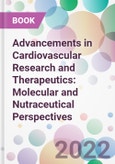Key Features
- 10 chapters that highlight recent research cardiovascular medicine and pharmacology
- Covers knowledge about basic cardiovascular physiology, congestive heart failure treatment and the treatment of heart inflammation.
- Covers uses, benefits, and drawbacks of numerous rodent and non-rodent animal models for studying CVD
- Updates readers about 21st-century CRISPR-cas9 technology and its uses in CVD.
- Covers the significance of Indian Ayurvedic techniques on the cardiovascular system,
- Covers information about nutraceuticals for CVD therapy
- Includes experiments to evaluate 3 phytochemicals for the treatment of different heart diseases such as hypertension, obesity-cardiomyopathy and the mitigation of inflammatory cytokines in myocardial infarction.
Table of Contents
Chapter 1. Introduction
1.1. Cardiovascular Disorders
1.2. Cardiovascular Diseases Burden: Global And National
1.3. Potential Risk Factors For Cvd
1.4. Therapies In Use For Cvd Treatment
1.4.1. Ace Inhibitors
1.4.2. Angiotension Ii Receptor Blockers
1.4.3. Antiarrhythmics
1.4.4. Antiplatelet Drugs
1.4.5. M. Anti-Coagulants Drugs
1.4.6. Diuretics
2. Nutraceuticals And Cardiovascular Health
2.1. Nutraceuticals
2.2. Potential Nutraceuticals
2.2.1. Plant Sterols/ Stanols
2.2.2. Cruciferous Vegetables
2.2.3. Garlic
2.2.4. Coq10
2.2.5. Turmeric
2.2.6. Grape Skin
2.2.7. Fish Oil/Olive Oil
2.2.8. Vegetables
2.2.9. Carnitine
2.2.10. Berberine
2.2.11. Flavonoids
2.2.12. Prebiotics
2.2.13. Probiotics
2.2.14. Protein And Protein Peptides
2.2.15. Vitamins
3. Nutraceuticals Modulate Genetic Expression
3.1. Nf-Κb Regulatory Network
3.2. Nrf2 Regulates Antioxidant And Detoxification Genes
4. Bioinformatics Application In Nutraceuticals And Cvd Prevention
4.1. Identification Of New Therapeutic Biomarkers
- Conclusion
- Consent For Publication
- Conflict Of Interest
- Acknowledgements
- References
Chapter 2 Congestive Heart Failure: Insight On Pharmacotherapy
1. Introduction
1.1. Hypertrophic Cardiomyopathy (Hcm)
1.2. Left Ventricular Noncompaction (Lvnc)
1.3. Arrhythmogenic Right Ventricular Cardiomyopathy (Arvc)
1.4. Restrictive Cardiomyopathy (Rcm)
2. Prevalence
3. Pathophysiology
4. Drug Therapy
4.1. Diuretics
4.2. Angiotensin Converting Enzyme Inhibitors (Ace Inhibitors)
4.3. Beta-Adrenergic Blocking Agents (Beta Blockers)
4.4. Vasopressin Receptor Antagonists
5. Management Of Heart Failure
5.1. Acute Decompensation
5.2. Chronic Management
5.3. Palliative Care
5.4. Cardiac Glycosides
5.4.1. Chemistry Of Cardiac Glycosides
5.4.2. Sources Of Cardiac Glycosides
5.4.3. Mechanism Of Cardiac Glycosides
5.4.4. Pharmacological Activity Of Cardiac Glycosides
6. Digoxin
7. Toxicokinetics
- Conclusion
- Consent For Publication
- Conflict Of Interest
- Acknowledgements
- References
Chapter 3 Diet, Inflammation And Cardiovascular Disorders
1. Introduction
1.1. Diet Induced Inflammation
1.2. Dietary Inflammatory Index (Dii)
2. Different Patterns Of Diet And Their Characteristics
2.1. The Zone Diet
2.2. Ketogenic Diet
2.3. Mediterranean Diet
2.4. Dash (Dietary Approaches To Stop Hypertension) Diet
2.5. The Paleo Diet
2.6. Vegan And Vegetarian Diet
3. Cardiovascular Diseases (Cvd), Pro And Anti-Inflammatory Agents
4. Spices
- Conclusion
- Consent For Publication
- Conflict Of Interest
- Acknowledgements
- References
Chapter 4 Rodent And Non-Rodent Animal Models For Cardiovascular Diseases
1. Rodent Models For Cvd
2. Atherosclerosis And Diabetic Models
2.1. Ldlr−/− Mice
2.2. Apoe−/− Mice
2.3. Sr-Bi Ko Mice
2.4. Db/Db Mouse
2.5. Ob/Ob Mice
2.6. Zucker Fatty Rat
2.7. Zucker Diabetic Fatty (Zdf) Rat
2.8. Otsuka Long-Evans Tokushima Fatty (Oletf) Rats
2.9. Goto-Kakizaki (Gk) Rats
2.10. Wnin/Gr-Ob Rat
3. Heart Failure Models
3.1. Myocardial Ischemia-Induced Heart Failure
3.2. Pressure Overload Models
3.3. Chemical-Induced Cardiomyopathy Models
4. Non-Rodent Models Of Cardio-Vascular Diseases
4.1. Overview Of Advantages And Disadvantages Of Non-Rodent Animal Models
4.2. Pigs
4.3. Atherosclerotic Disease Models
4.4. Pig Models For Stent Application
4.5. Pig Models Of Infarction And Heart Failure
4.6. Dogs
4.7. Sheep
- Conclusion
- Consent For Publication
- Conflict Of Interest
- Acknowledgements
- References
Chapter 5 Application Of 21St Century Genetic Engineering Tools And Crispr-Cas9 Technologies To Treat Most Advanced Cardiovascular Diseases Of Humans
1. Introduction
2. The Crispr/Cas9 Protein Technology
3. Application Of Crispr/Cas9 Technology As A Therapeutic Tool For Human Diseases
3.1. Cystic Fibrosis (Cf)
3.2. Sickle Cell Anemia
3.3. Thalassemia
3.4. Huntington’S Disease
3.5. Duchenne Muscular Dystrophy
3.6. Hemophilia
3.7. Chronic Granulomatous Disorders (Cgd)
4. Multifactorial Diseases
4.1. Cancer
4.2. Cardiovascular Diseases (Cvd)
5. Applications Of Crispr/Cas9 In Cardiac Research
5.1. Gene Therapy For Cvd
5.2. The Future Of Crispr/Cas9 Genome Editing In Cardiac Research
6. Challenges Of Application Of Crispr/Cas9
6.1. Delivery Systems Of Crispr/Cas9
6.2. Off-Target Effects
6.3. Ethical Issues
6.4. Emerging Crispr Technologies
- Conclusion
- Consent For Publication
- Conflict Of Interest
- Acknowledgements
- References
Chapter 6 Role Of Vyana Vayu In Cardiovascular System, Etiopathogenesis And Therapeutic Strategies: An Ayurveda Perspective
1. Introduction
2. A Preamble To Vata
2.1. Vyana Vayu
2.1.1. Role Of Vyana Vayu In The Heart
2.1.2. Role Of Vyana Vayu In Vasculature (Dhamani And Sira)
2.1.3. Role Of Vyana Vayu In Skeletal Muscles And Other Organs
3. Etiology
4. Pathogeneses
4.1. Stage Of Accumulation (Sanchaya)
4.2. Stage Of Aggravation (Prakopa)
4.3. Stage Of Dissemination (Prasar)
4.4. Stage Of Localization (Sthanasamshraya)
4.5. Stage Of Manifestation (Vyakta)
4.6. Stage Of Complication (Bheda)
5. Concomitant Concept
6. Clinical Implications
7. Treatment Strategies
7.1. Diet
7.2. Exercise
7.3. Pharmacological Approach
7.3.1. Terminalia Arjuna (Ta)
7.3.2. Innula Recemosa
7.3.3. Fagonia Arabica
8. Omics Study And Ayurvedic Therapeutic Strategies
- Conclusion
10. Highlights
- Consent For Publication
- Conflict Of Interest
- Acknowledgements
- References
Author
- V. V. Sathibabu Uddandrao
- Parim Brahma Naidu








